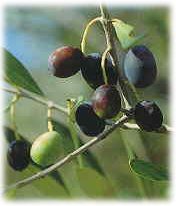taggiasca.com
The taggiasca olive
The tree

 The olive tree of taggiasca variety is a much vigorous tree, diffused mainly in the Western Liguria, with particular importance in the province of Imperia, where it becomes de facto the only one cultivar.
The olive tree of taggiasca variety is a much vigorous tree, diffused mainly in the Western Liguria, with particular importance in the province of Imperia, where it becomes de facto the only one cultivar.To go deeper in the argument read the page related to the cultivar taggiasca.
The log is usually much twisted, often with tilted growth, and rarely can be found two trees with similar growing.
For this reason it's often used as ornamental essence.
To go deeper in the argument consult the page related to the taggiasca as garden tree, or see the photographic gallery where some remarkable exemplars are shown.
The olive tree of taggiasca variety can exceed, if not controlled with the pruning, 10 meters of height: the Ligurian tradition, in fact, preferred trees with a remarkable vertical development.
The productive life of a tree begins after the third year, and can prolong for 600 years and over.
The seed reproduction is not used because seed-born trees trends to become wild.
The branches of and two years, already fruitful, are locally called "pendane", and once they were used as bedstead for stable animals.
The leaves are of medium width, somewhat rigid, wider at the apex that at the base and of a green pale, more bright in the upper face and tendentially silver in the lower face.
The blossoms of the olive tree, in Italian "mìgnole" (locally "paâne") are lengthened, with 15/20 flowers each of 4 petals of white-yellowish color.
The drupe, of black-violet color at complete maturation, has a lengthened, lightly cylindrical shape, and the weight goes from 2 to 4 grams.
Who loves "strong" tastes can directly eat olives picking them from the tree, but it's better to do this only with much mature fruits. After some moments of bitter taste will remain an aftertaste extremely pleasant.
copyright © 1999 - 2000 by It-Web Information Technology - all rights reserved